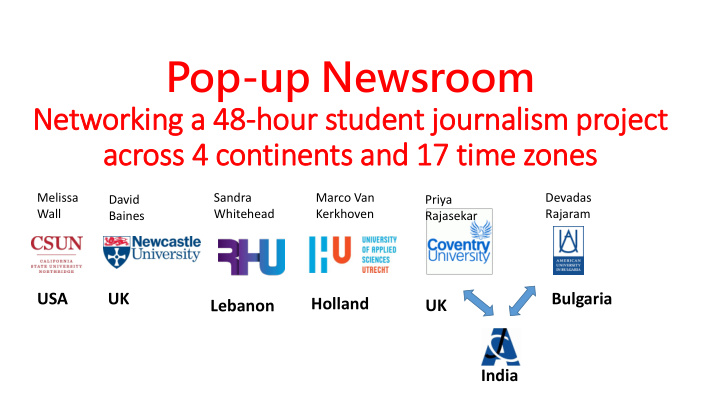



Pop-up Newsroom Networking a 48-hour student journalism project across 4 continents and 17 tim ime zones Melissa Sandra Marco Van Devadas David Priya Wall Whitehead Kerkhoven Rajaram Baines Rajasekar USA UK Bulgaria Holland Lebanon UK India
The story ry – it it grew out of WJEC4 in in Belg lgium • Melissa Wall presented on CSUN Pop-Up news projects in Los Angeles: - LA Marathon - US Presidential Election - Long-Distance Bus Passengers The Pop-Up Newsroom: a temporary virtual newsroom that has no permanent space or location – born 2012, California. • David Baines on NU hyper-local site and pop-up magazine: - Turner modern art prize ‘… Let’s join up and do one internationally ’ 2
Networks - growth National Chung Cheng University, Taiwan Asian College of Journalism, India
How it it works • Students research topic • Practice reporting on social and mobile platforms • Build contacts for live reporting on the day • Some might prepare reports to release on the day • It starts in California and rolls round the world as students pass the baton to each other • Content aggregated - on dedicated websites - through Twitter hashtags - on Facebook
st glo 1 st lobal topic – poverty and deprivation • Improving students ’ news literacy regarding the subject matter – poverty • Explored the ways in which: - students could use new media tools to produce live news in new ways - they could engage with complex issues through mobile technology and social media platforms - they could produce journalism without a real-world newsroom • Allowed students to explore new paradigms of networked and participatory journalism
Outcome • The project brought many more people into the conversation than the students themselves. • TweetReach analytics - hashtag #livepoverty reached 54,590 Twitter accounts over 48 hours • #IWDpopup – when we covered International Women’s Day 2014, reached 187,295 accounts http://www.nordicom.gu.se/sites/default/files/publikatione r-hela-pdf/global_citizenship_in_a_digital_world.pdf
Outcome • International aspect helped students develop understanding of poverty and how it is constructed by media • How local conditions and values shape those constructions • It encouraged students to seek out unheard voices • To share control of the narrative • To host a conversation and help to encourage participation and curate new contributions
Outcome • It helped students exercise greater levels of independence • to rely more on engagement with communities they were reporting on. • Embracing the power of networked communication helped them see their roles in civic life as interconnected with their sources • Revealed the possibilities of global teamwork. http://civicmediaproject.org/works/civic- media-project/pop-up-newsroom
Track record It has included • Nov 2013: Poverty and Austerity US, India, • March 2014: International Women’s Day Holland, UK, • Nov 2014: Food Lebanon, • March 2015: International Women’s Day Bulgaria, • Nov 2015: Migration and Human Rights Brazil, • March 2016: International Women’s Day Armenia, • November 2016 - Taiwan
Pop-Up maps onto in internatio ional journalism collaborations Maps onto in internationalisatio ion of university programmes
What works • Topic must work for everyone (migration crisis was less an issue for India) • Use local connections to partners in other countries • Importance of personal connections • It is flexible – we do not all have to do everything the same way
Challenges • Time zones – for live reporting and getting students to communicate • Language – what happened with Chinese, etc. Common language helps • Just because technology enables easy communication doesn’t mean students will automatically work with those not co-present • Popularity of particular social media platforms varies across regions and nations
….depth of engagement ‘ When my students reported on the Syrian refugees in Lebanon one of the most important impacts I noticed was that they developed understanding and empathy for the refugees when explaining their situations to an international audience. ‘For the Lebanese audience … they felt like "everyone knew" the situation of the refugees. ‘So having an international audience created the need for more in depth reporting .’ Sandra Whitehead, Rafik Hariri University, Lebanon
Depth of engagement ‘Our students in India struggling for free wifi spaces - some reported checking into bars (not always the safest bet) and charging their phones in petrol stations. ‘They were very resourceful and even the shy ones returned with great content having managed to find ways to solve problems. ‘Back in Coventry, I found that wifi was rarely an issue and students were happy to use their 3G or 4G connections. That said, there was a lesser likelihood that they would step outside their comfort zones Priya Rajasekar, Coventry University - ex Asian College of Journalism
Lik ike to come on board? • Melissa Wall: melissa.a.wall@csun.edu • Marco van Kerkhoven: marco.vankerkhoven@hu.nl • Whitehead; Sandra whiteheads@rhu.edu.lb • Devadas Rajaram drajaram@aubg.edu • Priya Rajasekar ac1503@coventry.ac.uk • David Baines: david.baines@ncl.ac.uk
Recommend
More recommend